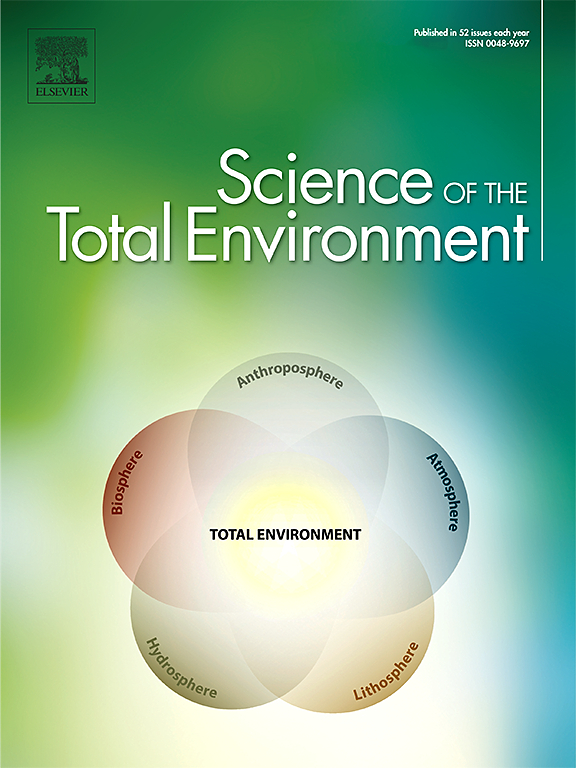Validation of GEMS operational v2.0 total column NO2 and HCHO during the GMAP/SIJAQ campaign
IF 8.2
1区 环境科学与生态学
Q1 ENVIRONMENTAL SCIENCES
引用次数: 0
Abstract
The Geostationary Environmental Monitoring Spectrometer (GEMS), the first geostationary air quality instrument, onboard the GEO-KOMPSAT-2B (GK2B) satellite, produces hourly observations over Asia with 3.5 km 8 km spatial resolution. To evaluate the GEMS L2 products, the National Institute of Environmental Research (NIER) organized the GEMS Map of Air Pollutants 2021 (GMAP2021) and the Satellite Integrated Joint monitoring of Air Quality 2022 (SIJAQ2022) campaigns during October 2021 to November 2021 and from June 2022 to July 2022, respectively. While GMAP2021 mainly targeted the SMA (Seoul Metropolitan Area), the SIJAQ2022 campaign extended to the southeastern area of South Korea. In this study, a comparison between Pandora and Multi-AXis Differential Optical Absorption Spectroscopy (MAX-DOAS) products and an evaluation of the GEMS operational v2.0 total column NO2 and HCHO products are conducted.
A comparative analysis between the Pandora (P189) and the IUP Bremen MAX-DOAS instrument at the Incheon NIER-ESC site was performed to analyze discrepancies between the retrieval processors (Pandora: PGN official processor, MAX-DOAS: MMF in FRM4DOAS framework). Aligning the viewing directions of both Pandora and MAX-DOAS leads to a significant increase in the slope and correlation coefficient from 0.87 to 0.96 and from 0.86 to 0.96, respectively, in the case of NO2 tropospheric columns. Similarly, for HCHO tropospheric columns, slope and correlation coefficient change from 0.94 to 1.09 and from 0.81 to 0.90 when matching the viewing geometries of both instruments. In contrast to tropospheric columns, total HCHO columns derived from Pandora (P189) direct-sun measurements show significantly larger values than the MAX-DOAS ones, with a mean relative difference (MRD) of 126 %. This bias can however be reduced to 33 % after suitable adjustment of the direct-sun retrieval settings.
The GEMS v2.0 NO2 total column product, evaluated over 6 official PGN sites in South Korea, shows good agreement with a correlation coefficient of 0.87 and similar seasonal and diurnal NO2 variation. However, GEMS tends to report higher values than Pandora with a mean relative difference of +41 %. The magnitude of the GEMS overestimation is amplified in highly polluted conditions (i.e. during winter and at noontime).
Compared to 6 MAX-DOAS stations and 6 Pandora stations, the GEMS HCHO product captures well the seasonal and diurnal variation of HCHO and shows good agreement both with MAX-DOAS and Pandora with slopes of 0.84 and 0.79, respectively, and correlation coefficients of 0.86 for both. Large columns, however, tend to be systematically underestimated.

求助全文
约1分钟内获得全文
求助全文
来源期刊

Science of the Total Environment
环境科学-环境科学
CiteScore
17.60
自引率
10.20%
发文量
8726
审稿时长
2.4 months
期刊介绍:
The Science of the Total Environment is an international journal dedicated to scientific research on the environment and its interaction with humanity. It covers a wide range of disciplines and seeks to publish innovative, hypothesis-driven, and impactful research that explores the entire environment, including the atmosphere, lithosphere, hydrosphere, biosphere, and anthroposphere.
The journal's updated Aims & Scope emphasizes the importance of interdisciplinary environmental research with broad impact. Priority is given to studies that advance fundamental understanding and explore the interconnectedness of multiple environmental spheres. Field studies are preferred, while laboratory experiments must demonstrate significant methodological advancements or mechanistic insights with direct relevance to the environment.
 求助内容:
求助内容: 应助结果提醒方式:
应助结果提醒方式:


